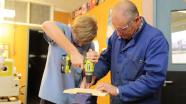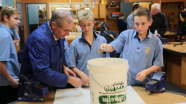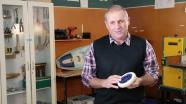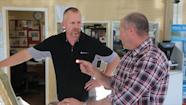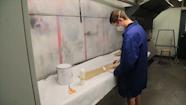Exploring unfamiliar materials
Two year 12 students from St John's College describe what they know about bamboo and how they are applying this knowledge to their projects. They describe processing the bamboo as a raw material and how this has grown their material understandings.
Duration: 02:44
Transcript
Student 1: The process we went through to get the bamboo was, first, we had to go basically cut it down.
Student 2: And we’ve bought it into school and we’re just mucking around with it at the moment.
Student 1: Originally, it was that we got big pieces like this, this one here. So we bought it back to school and then we realised that it actually was too green to be used. So then what we did with Mr Andrews was we, first we cut it into lengths. So we cut it down the middle, and then what we did is we developed a drying oven to actually put the bamboo in the drying oven and dry it out. Otherwise, it would take six, about six months to naturally dry out.
Student 2: We’ve cut them into thinner strips and then put them through the thicknesser, and that’s how we got sort of flat strips like this. We knew what sort of equipment and tools to use because we’d done stuff before with other materials from previous years and projects. So we sort of just applied our knowledge of timbers to the bamboo.
Student 1: So what we’ve found out from the bamboo so far is that it can be machined as is shown here. It can be put through machines, it can be cut, it can be dried out, which is in a faster way than what it naturally is. And we also found out through testing that the bamboo flexes more this way than what it does this way. And it’s stronger this way. So you can see you can actually bend it right around until it breaks, until about ... breaks properly (it’s actually quite strong this one) like that. And then this way it’s a lot harder, and it splits like that.
The way I’m going to apply it to my project is the part that is stronger is going to go on the top of my board. So if I was to use bamboo, it would be this part here because it’s stronger and so it will make my project overall stronger and it won’t snap or break.
Student 2: The main force on my board is going to be downwards force and drag from the water, and so the bamboo is going to have to go this way on the bottom because that’s the way it flexes and it’s stronger this way. And yeah, and so it’s going to stand up to the forces that are applied onto it. And so it’s going to compress down and expand on the bottom without breaking.
Curriculum links
Follow the link below to view a diagram showing the structure of the strands and components within technology:
The students in the video are talking about bamboo as a material. Understandings of materials form an integral part of the technological products component. These understandings also feature within the outcome development and evaluation component. Select the links below to read more about these components:
Reflective questions
- What opportunities do I provide for students to process raw materials?
- Do our junior programmes provide students with the confidence to explore and consider a range of materials for the products they are developing when they are in the senior school?
Related resources
Resources
- Crossroads Church sign: A senior student learns about materials and their performance properties when creating a road-side sign for a church.
- Local curriculum in technology using a light festival: Year 7–10 students learn about unfamiliar materials, their performance properties, and new ways to use familiar materials to make installations for a local light festival.
Technology in the news
- Why bamboo is booming again in Taiwan: Bamboo has been used to make items never before associated with it – from shampoo and insect repellent, to socks, gloves, and even roasted peanuts.
- Bamboo furniture by Taiwanese studio scope design: Five different seating pieces have been presented at Taiwan designers' week.
Note that you can search the news section by using the keywords under each item.
More videos
Combining knowledge and practice
In this video Steve Andrew describes how focusing on technological products gives depth to technology teaching and learning at St John's.
Linking hands-on experiences and understandings
Terry Mitchell, Steve Andrew, and their students show how making whistles from aluminium and from plastic provides a great context for discussing the properties of materials.
Play, experiment, explore
Steve Andrew shares how and why he has the students see, feel, and play with products to develop their understandings in materials.
Finding materials to meet the specs
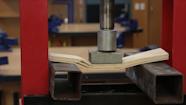

Steve Andrews shares how students identify material specifications in a brief and then test materials to find those that are suitable.
School–industry relationship cuts both ways
Steve Andrew and Terry Rillstone describe the way the relationship between St John's College and The Shop has benefits for them both.
Pushing the boundaries with materials
Steve Andrews describes how his senior students have the confidence to select and work with unfamiliar materials.

